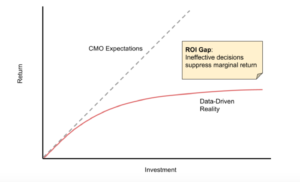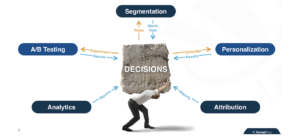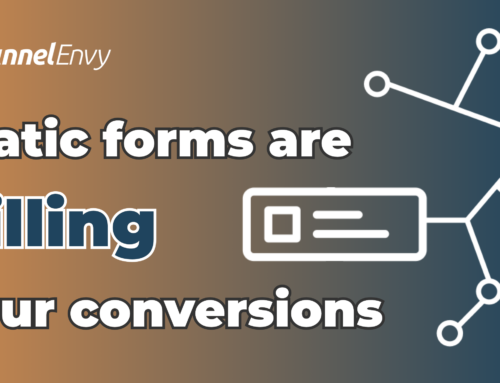The term cobra effect describes an incentive policy that causes unintended consequences and results in the opposite effect intended. In the 1800s the colonial government of India (as the story goes), becoming increasingly concerned about the population of cobras in Delhi, offered a bounty for every dead cobra brought in.
Although it was initially successful, the cobra population increased as entrepreneurs of the day started breeding cobras to take advantage of the bounty. When the government realized the new policy wasn’t working as intended they ended the program, causing the cobra farmers to release the snakes and further exacerbating the very problem the government wanted to solve.
I recently read Chief Marketing Officers at Work, a fantastic series of interviews of CMOs from prominent companies like PayPal, Zendesk, Domo and SurveyMonkey. These marketing leaders unequivocally championed their data-driven marketing strategies, and emphasized the need for further data-driven investment and skills in their organizations.
The root cause of many cobra effect problems is the fact that as humans we tend to more easily comprehend simplistic linear systems and cause-effect relationships. Much like rewarding people for killing cobras should result in less cobras, investing in more data-driven tools should produce better decisions and outcomes!
Unfortunately, it’s very likely that the data-driven approaches being increasingly adopted by marketing organizations are producing their own cobra effect and paradoxically reducing the quality of decisions and resulting outcomes.
If Data is the oil, Decisions are the engine

The Economist recently wrote that data is the new oil. We’re in an age of data abundance. Ten years ago there were 1 or 2 companies which provided reverse IP based firmographic data for marketers. In a relatively cursory search I recently found over 60.
Almost all of the thousands of marketing and sales tools out there now have an API. Customer data platforms have made it easier to aggregate and unify that data.
So if data is the new oil that fuels an organization’s decision making and if everyone has access to a surplus of data, then organizations must differentiate and compete on the utility of that data. Specifically its ability to improve decision making. Then every new marketing tool must be evaluated on the marginal improvement that it has on decision making.
Instead of evaluating your organization’s ability to compete solely on the basis of your data, it’s more relevant to think about the total leverage you get from that data in the form of decisions and outcomes.
Are we actually improving decisions?
There’s no doubt that access to data about our marketing activities is a significant improvement over the Mad Men approach to marketing of decades ago. Analytics, attribution, experimentation and similar tools provide much needed quantitative feedback, evidence and yes, support better decision making.
The problem comes from the assumption that continued investment in these tools will lead to corresponding improvements in outcomes.
A common problem in our ability to reason about cause and effect comes from systems which are siloed from one another, but nevertheless are interdependent. This happens when the CMO or other marketing leader purchases a new tool but the team can’t adopt or get results from it. This ultimately results in a non-linear, diminishing relationship between investment and return and organizational dissonance between what the CMO believes they’re investing in and what they’re actually getting.

Whether you call it shelf-ware, abandonware or some other term, it’s all too common in martech. Why does this happen?
The Decision Burden
To better understand this phenomenon let’s think about what our B2B marketer has to do to properly execute a personalization campaign using all of the latest data-driven tools.
- Starting with analytics she’ll look through some reports and make a decision about what she’s observing in the data.
- Knowing that she should run an experiment before she does any personalization, she’ll make decisions on the hypothesis and test design.
- After running the test, she’ll look at the results and decide how to proceed.
- If the experiment suggests a personalization campaign, she’ll make more decisions on the segments to create.
- Of course because she’s using rules for the segments, she’ll have to evaluate how well they match the intended audience and decide if the segment is going to be effective.
- Once the segments are ready, she’ll have to create a campaign and decide what experiences to show to each of the segments.
- She’ll run the campaign, look at the results and make an initial decision as to how effective it was.
- Finally, being a B2B marketer who’s concerned about pipeline and revenue, she’ll pull up an attribution report to decide if the campaign results actually affected her KPIs.

Of course all of these decisions assume that everything actually works. If an experiment doesn’t conform to the hypothesis or the segments don’t match as intended there’s the likelihood of significant error and additional decisions.
The Impact of Decision Burden
In the book Willpower: Rediscovering the Greatest Human Strength the social psychologist Roy Baumeister writes about Decision Fatigue, a symptom of what happens when humans are burdened with too many decisions.
In the section on Decision Fatigue, Baumeister argues that there’s a finite amount of willpower available for decisions, and every time you are forced to make one it saps some of that willpower. Once this “willpower reserve” is depleted you end up being more impulsive, introducing more subjective bias, and making lazier choices – effectively reducing decision quality.

You’ve seen other marketers take advantage of this every time you see the tabloids and candy bars at the checkout aisle at the grocery store or signed up for the expensive rust proofing option after you’ve negotiated every other option.
This is the source of the paradox. For every new tool the CMO adds to the stack we’re encumbering the team with more decisions without adding hours to the day. And if they’re ability to make effective decisions is the most important contributor to marketing and business outcomes, we’ve reduced the likelihood that we will achieve those outcomes.
There are decisions that we as humans excel at and which no machine will be able to replicate in our lifetime. These are the truly impactful decisions that live outside of what a machine can resolve and include developing a true understanding our customers and creating ways to engage them. Unfortunately these are increasingly being crowded out as we fight through the data-drudgery.
If a new report is created and no one looks at it does the tree make any noise?
The consequences to the current era of manual decisioning aren’t limited to the realm of social psychology, there are hard dollars at stake as well. Consider that for each of the following assets in the modern, data-driven martech stack there are real human activities, hours and associated recurring costs to recoup investment from them.

If you are investing in tools which produce these assets and rely on humans to extract value you must scale your team accordingly. These include marketing operations, demand generation, content, website marketing to keep pace with the increasing burden of decisions being placed on them.
And of course you better hope that they don’t get fatigued, skip steps, make compromises or ever take days off.
The New Autonomous Era
We’re currently in an era of Marketing Automation which has done wonders in terms of providing us data and automating process. As we’ve seen however the new currency in the era of data abundance will be the decisions and so at FunnelEnvy we believe new winners will embrace Autonomous Marketing.
Autonomous Marketing automates both the process and the decisions and doesn’t suffer from the same limitations of manual decisioning. Machines excel at incorporating vast amounts of data and can make decisions on an individual (1:1) basis, without bias and fatigue.
Our marketing teams stand to gain the most from the Autonomous Marketing era. Their time is better spent doing what marketers do best – developing a deeper understanding of customers and identifying new and innovative ways to engage.
Organizations that successfully make the leap to autonomous marketing and customer experiences will surge ahead of their competitors and like any major shift there will be winners and losers:
- Losers (marketing automation) – Diminishing ROI, focus on tool integration, bloated and sales-driven go to market structures.
- Winners (autonomous marketing) – Accelerating ROI, integration of better decisions, agile and marketing-led go to market structure.
Most importantly in an autonomous marketing era we re-align the expectations of the CMO to the outcomes of the marketing team, ensuring that the investments that are made, align with the highest return aspects of the team function – the decisions.





